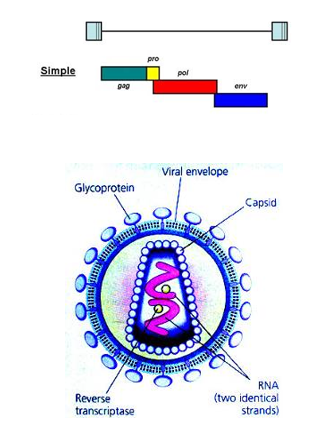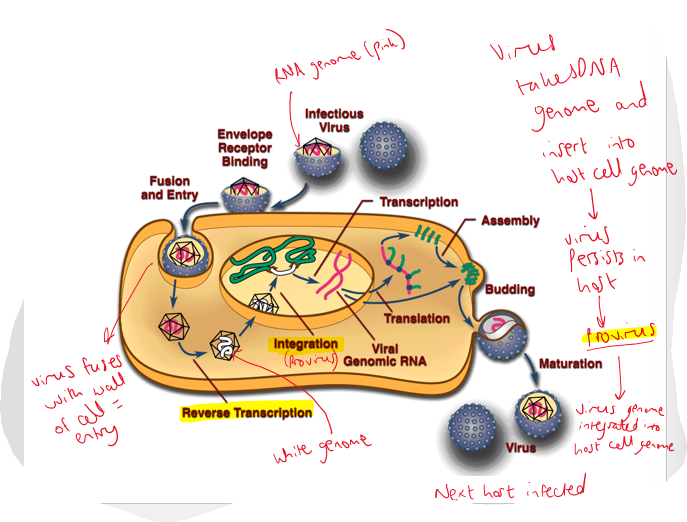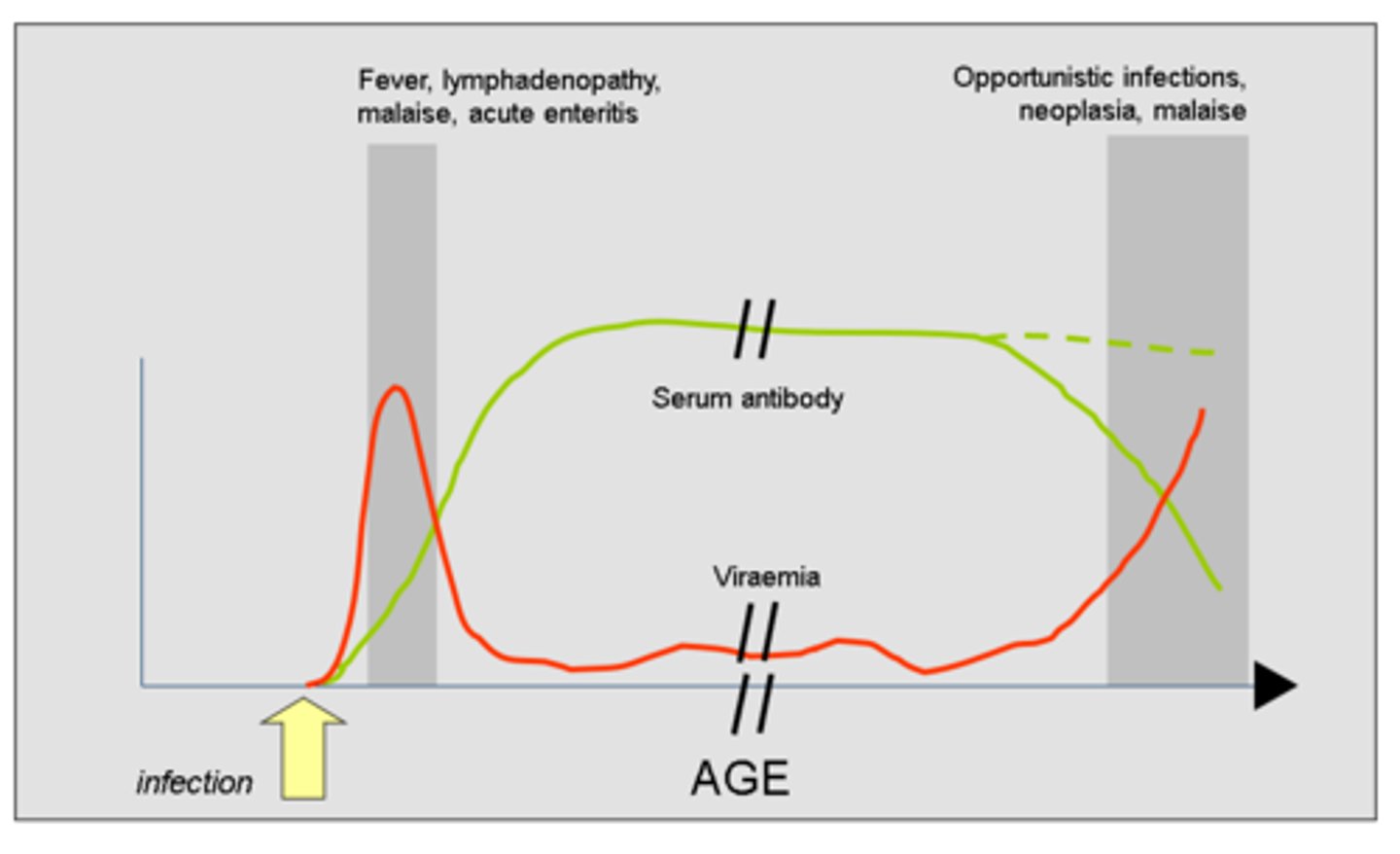Feline Retroviruses
1/57
There's no tags or description
Looks like no tags are added yet.
Name | Mastery | Learn | Test | Matching | Spaced |
|---|
No study sessions yet.
58 Terms
What are the main feline retroviruses?
Feline Leukaemia Virus (FeLV)
Feline Immunodeficiency Virus (FIV)
Feline syncytium-forming virus (FeSFV)
Endogenous viruses —> share FeLV-like sequences
How are viruses classified?
The genome (RNA or DNA)
Number & sense (+ve or -ve) of RNA/DNA strands
Morphology
Genome sequence similarity
Ecology
What are the characteristics of Retroviridae?
Lipid envelope —> susceptible to detergents
single-stranded RNA virus
Have 4 main types of coding proteins (gag, pro, pol and env)

What does gag encode?
matrix, capsid, nucleocapsid
i.e. inside of virus
What does pro encode?
Viral protease.
What does pol encode?
Reverse transcriptase.
What does env encode?
Glycoprotein and transmembrane protein that interacts with cellular receptor proteins.
What is a good way of controlling retroviruses? Why?
Simple disinfection as they have a lipid envelope that can easily be destroyed.
Describe the life cycle of a retrovirus
1) Turns RNA genome to DNA genome
2) They then integrate their DNA into the chromosome of the host
3) The host makes RNA copies of the retrovirus
4) The virus then buds off and the cycle repeats

Will an infected host cell with a retrovirus carry the DNA of the retrovirus into the daughter cells?
Yes.
What is the function of reverse transcriptase in retroviruses?
Makes DNA from RNA and inserts the copied DNA into the host genome via integrase.
What is the function of integrase?
Binds both the viral cDNA generated by reverse transcriptase & the host DNA —> insertion of the viral genome into the host DNA
What are endogenous retroviruses?
Evolutionary remnants of retroviruses that are silent parts of an animals genome.
What are the 3 subtypes of FeLV? How do you distinguish between the subtypes?
A, B & C.
distinguished by genome analysis & serology
What is the most common and only transmissible subtype of FeLV?
A.
What are type B and C subtypes of FeLV?
Recombinants between type A and endogenous retroviruses or mutants of type A.
Where are type B and C subtypes of FeLV found?
Only with type A as they need it for replication.
What are the different routes of infection for FeLV?
Direct contact
Via ingestion of saliva, urine, faeces and milk
Requires close (friendly) contact
Vertical, transplacental transmission
Describe the pathogenesis of FeLV
1) Ingestion and replication in oropharynx & local lymph nodes
2) Primary viraemia —> antigen positive, antibody negative
3) Replication in other lymphoid tissues, bone marrow etc.
4) Secondary viraemia —> antigen positive, antibody positive
5) Persistent viraemia
What do primary and secondary viraemia of FeLV lead to?
Persistent, latent infection.
What does persistent viraemia of FeLV lead to?
Clinical disease & death (ineffective immune response)
What does it mean if a cat has persistent, latent infection with FeLV?
There are no clinical signs of disease but the virus persists in the cat and can (but not necessarily will) still transmit the disease.
What are the serological differences between a cat that is in primary viraemia with FeLV and one that is in secondary viraemia with FeLV?
Primary = Provirus positive, antigen positive, antibody negative, virus positive
Secondary = Provirus positive, antigen positive, antibody positive, virus positive
What are the serological characteristics of a cat that has a persistent latent infection of FeLV?
Provirus positive (but low), antigen negative, virus negative, antibody positive.
What are the determinants of which type of viraemia (e.g. primary, secondary) a cat experiences with FeLV?
Dose of virus
contact with persistently infected cats
in utero transmission
Age
susceptibility to persistent infection decreases with age
Immune status
maternally derived antibody protective for 4 weeks
What are the common syndromes caused by FeLV?
R eproductive failure
A nemia
I mmunodeficiency
N eoplasia
What types of lymphoma are caused by FeLV?
mediastinal (thymic)
multicentric
alimentary
leukaemic
(also found in the kidney, nose, eye, skin, and CNS)
How does FeLV lead to neoplasia (tumour formation)?
Sporadic insertion of FeLV A may:
Activate a proto-oncogene
Disrupt a tumour suppressor gene
What are the implications of a mediastinal lymphoma on a cat?
Tachypnoea, dyspnoea
Regurgitation, weight loss
Muffled heart sounds and increased thoracic resistance
What are the implications of a multicentric lymphoma on a cat?
Any organ/tissue may be involved
- Often causes mild anaemia
What are the implications of a cat with an alimentary lymphoma?
Anorexia
Weight loss
Vomiting
What are the implications of a cat with leukaemia (bone marrow)?
Raised WBC
Anaemia
Thrombocytopenia
Haemorrhage
Pyrexia
Weakness
Anorexia
What is the most common cause of anaemia in cats?
FeLV.
Describe primary FeLV-related anaemia
Red blood cell aplasia (low WBC, RBC <10%)
Non-regenerative
Associated with subtype C & mutation that allows infection of erythroid precursors
Describe secondary FeLV-related anaemia
Regenerative
Due to space-occupying myeloid tumours in bone marrow
Haemolytic anaemia common
What subtype of FeLV can cause non-regenerative anaemia?
C
What can FAIDS lead to (immunosuppression)?
Secondary infections
Poor wound healing
Abscessation
Chronic respiratory/enteric infections
Thin, persistently ill
PUO (pyrexia of unknown origin)
Gingivitis/stomatitis
What is the effect of FeLV on the reproductive system of cats?
Causes resorption of fetuses at 3-5 weeks pregnancy
Possible seen as slight vulval discharge
If survive to birth, kittens persistently infected —> fading kitten syndrome
How can we control FeLV?
Test and remove infected animals —> rehome or euthanase
Vaccination
One food bowl per cat!!
What test can we use for diagnosis of FeLV?
Lateral flow test.
How often should you test for FeLV?
From the first test, then 12 weeks later.
After, this should be done every 6-12 months —> all cats entering colony
After testing for FeLV, which cats should you remove?
Those that have tested positive both times as they are exhibiting chronic viraemia.
When can you give the vaccine for FeLV?
8-9 weeks old and then 3 weeks later.
Is the vaccine for FeLV a core vaccine?
No.
How can we treat cats with FeLV?
Mostly supportive care (no specific antivirals)
Can treat some lymphomas with cytotoxic drugs
Can use interferon therapy (may improve prognosis)
Need to advise mainly about reducing onward transmission
What is a good indicator on whether interferon therapy is working on a cat with FeLV?
Whether the cat still has anaemia.
Describe FIV
A lentivirus, related to HIV
Causes immunodeficiency in cats —> associated with variety of lesions
NOT zoonotic
Which cats is FIV more common in?
More common in males than females
More common in free-roaming & feral cats & those living in unstable colonies
How is FIV transmitted?
Mainly by biting through transmission of saliva
Transplacental & milk transmission is possible but rare
Describe the pathogenesis of FIV
Virus infects immune cells —> lymphocytes, Cd4+, macrophages, kuppffer cells, astrocytes
Where can FIV be isolated from?
Blood, cerebral spinal fluid (CSF), lymphoid organs & saliva.
What are the effects of FIV?
Gradual decline of:
Cd4
Mitogen and antigen proliferation assays
Expression of MHC class 2
How long do cats normally survive with FIV?
3-5 years.
What is the incubation period of FIV?
1 week.
How can we treat cats with FIV?
Supportive care to prevent secondary infections
Describe the serological changes that occur from the point of infection of FIV
1) Virus in blood rapidly decreases over 1 week
2) Then the virus decreases in levels as serum antibody increases massively
3) After a few weeks, the levels of viraemia decreases but serum antibody remains high
4) 4-6 weeks post-infection serum antibody levels begin to decline and viraemia reoccurs

How can we prevent and control FIV?
Prevent cats fighting each other —> keep indoors or neuter
Isolate infected cats
Is there a vaccine available for FIV in the UK?
No —> none licensed.